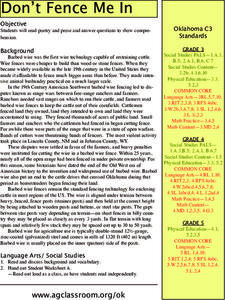C-SPAN
Voting Discrimination and the Effects of Shelby County v. Holder
Show students that every vote counts as they debate the federal government 's role in protecting voting rights in historically racially discriminated areas. In the Supreme Court case Shelby County v. Holder, the high court found...
Curated OER
History of Irrigation on the Great Plains
Students explore irrigation in the Great Plains throughout history. In this irrigation lesson, students listen to their instructor present a lecture on the history of irrigation in the world and on the Great Plains. Students conduct...
Curated OER
Hoboes on Harvest
Learners study the role Oklahoma's wheat fields played in the history of labor movements in the US. They write imaginary letters describing their experiences on a wheat harvest. They research on the internet or in encyclopedias to find...
Curated OER
Don't Fence Me In
Ensure that your class has a well-rounded understanding of new inventions, in this case barbed wired. Class members, after researching the history and development of barbed wire, assess its impact on cattle and the development of the...
Curated OER
Economic Use of Public Natural Areas
Students examine the public controversy between the use of public natural areas for economic activities by viewing video clips, researching on the Internet, and calculating sustainable land.
Cayuse Canyon
The Us50
This clickable map of the United States gives students access to research information from history and tourism to attractions and famous historic figures.
Smithsonian Institution
National Museum of Natural History: American Mammals: Texas Kangaroo Rat
Texas Kangaroo Rats live in only a few counties of north-central Texas, although the species was once also present in Oklahoma. They prefer to live where soils have a high percentage of clay. Learn more about the Dipodomys elator, more...






